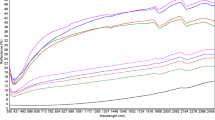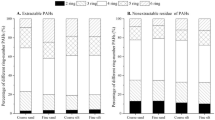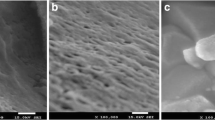Summary
Polycyclic aromatic hydrocarbon (PAH) biodegradation was investigated in contaminated soils from two different industrial sites under simulated land treatment conditions. Soil samples from a former impregnation plant (soil A) showed high degradation rates of PAHs by the autochthonous microorganisms, whereas PAHs in material of a closed-down coking plant (soil B) were not degraded even after inoculation with bacteria known to effectively degrade PAHs. As rapid PAH biodegradation in soil B was observed after PAHs were extracted and restored into the extracted soil material, the kind of PAH binding in soil B appears to completely prevent biodegradation. Sorption of PAHs onto extracted material of soil B follows a two-phase process (fast and slow); the latter is discussed in terms of migration of PAHs into soil organic matter, representing less accessible sites within the soil matrix. Such sorbed PAHs are suggested to be non-bioavailable and thus non-biodegradable. By eluting soil B with water, no biotoxicity, assayed as inhibition of bioluminescence, was detected in the aqueous phase. When treating soil A analogously, a distinct toxicity was observed, which was reduced relative to the amount of activated carbon added to the soil material. The data suggest that sorption of organic pollutants onto soil organic matter significantly affects biodegradability as well as biotoxicity.
Similar content being viewed by others
References
Bewley R, Ellis B, Theile P, Viney I, Rees J (1989) Microbial clean-up of contaminated soil. Chem Ind 23:778–783
Blumer M, Youngblood WW (1975) Polycyclic aromatic hydrocarbons in soil and recent sediments. Science 188:53–55
Bonaccorsi A, Domenico A di, Fanelli R, Merli F, Motta R, Vanzati R, Zapponi GA (1984) The influence of soil particle adsorption on 2,3,7,8-tetrachlorodibenzo-p-dioxin biological uptake in the rabbit. Arch Toxicol Suppl 7:431–434
Brown KW, Donnelly KC, Thomas JC, Davol P, Kampbell D (1985) Degradation of soil applied organic compounds from three petroleum wastes. Waste Manage Res 3:27–39
Callahan MA, Slimak MW, Gabel NW, May IP, Fowler CF, Freed JR, Jennings P, Durfee RC, Whitmore FC, Maestri B, Mabey WR, Holt BR, Gould C (1979) Water related environmental fate of 129 priory pollutants, vol II. Halogenated aliphatic hydrocarbons, halogenated ethers, monocyclic aromatics, phthalate esters, polycyclic aromatic hydrocarbons, nitrosoamines and miscellaneous compounds. EPA-440/4-79-029 b
Cerniglia CE (1984) Microbial metabolism of polycyclic aromatic hydrocarbons. Adv Appl Microbiol 30:31–71
Chiou CT, Malcolm RC, Brinton TI, Kile DE (1986) Water solubility enhancement of some organic pollutants and pesticides by dissolved humic and fulvic acids. Environ Sci Technol 20:502–508
Clark KR, Owens NJP (1983) A simple and versatile micro-computer program for the determination of most probable number. J Microbiol Methods 1:133–137
Codner RC (1969) Solid and solidified growth media in microbiology. Methods Microbiol 1:427–454
DIN-Entwurf 38414 Teil 4 (1984). VCH Weinheim
DIN-Entwurf 38412 Teil 34 (1991). VCH Weinheim
Dipple A (1976) Polynuclear aromatic carcinogens. In: Searle CE (ed) Chemical carcinogens, ACS Monograph 173. American Chemical Society, 173, pp 245–314
Dzombak DA, Luthy RG (1984) Estimating adsorption of polycyclic aromatic hydrocarbons on soils. Soil Science 137:292–308
Gibson DT, Subramanian V (1984) Microbial degradation of aromatic hydrocarbons. In: Gibson DT (ed) Microbial degradation of organic compounds. Dekker, New York, pp 181–252
Hambsch B, Pelouin C, Werner P (1990) Bioluminescence test as a surrogate parameter for the toxicity of hazardous substances in refineries. Vom Wasser 74:65–74
Karickhoff SW (1980) Sorption kinetics of hydrophobic pollutants in natural sediments. In: Baker RA (ed) Contaminants and sediments, vol 2. Ann Arbor Science, Ann Arbor, pp 193–205
Karickhoff SW, Brown DS, Scott TA (1979) Sorption of hydrophobic pollutants on natural sediments. Water Res 13:241–248
Kingsbury GC, Sims RC, White JB (1979) Multimedia goals for environmental assessment. EPA-600/7-79-176 b
Krieg NR, Holt JG (1984) Bergey's manual of determinative bacteriology, vol 1, Williams and Wilkins, Baltimore
LaFlamme RE, Hite RA (1978) The global distribution of polycyclic aromatic hydrocarbons in recent sediments. Geochim Cosmochim Acta 42:289–303
Manilal VB, Alexander M (1991) Factors affecting the microbial degradation of phenanthrene in soil. Appl Microbiol Biotechnol 35:401–405
Martin JP, Parsa AA, Haider K (1978) Influence of intimate association with humic polymer on biodegradation of 14C-labelled organic substances in soil. Soil Biochem 10:483–486
McCarthy JF, Jimenez BD (1985) Interactions between polycyclic aromatic hydrocarbons and dissolved humic material: binding and dissociation. Environ Sci Technol 19:1072–1076
Means JC, Wood SG, Hassett JJ, Banwart WL (1980) Sorption of polynuclear aromatic hydrocarbons by sediments and soils. Environ Sci Technol 14:1524–1528
Morgan P, Watkinson RJ (1989) Hydrocarbon degradation in soils and methods for soil biotreatment. Crit Rev Biotechnol 8:305–333
Mueller JG, Chapman PJ, Pritchard PH (1989) Creosote contaminated sites: their potential for bioremediation. Environ Sci Technol 23:1197–1201
Mueller JG, Middaugh DP, Lantz SE, Chapman PJ (1991) Biodegradation of creosote and pentachlorohenol in contaminated groundwater: chemical and biological assessment. Appl Environ Microbiol 57:1277–1285
Ogram AV, Jessup RE, Ou LT, Rao PSC (1985) Effects of sorption on biological degradation rates of (2,4-dichlorophenoxy)acetic acid in soils. Appl Environ Microbiol 49:582–587
Pahlmann R, Pelkonen O (1987) Mutagenicity studies of different polycyclic aromatic hydrocarbons: the significance of enzymatic factors and molecular structures. Carcinogenesis 8:773–778
Pfennig N, Lippert KD (1966) Über das Vitamin-B-12-Bedürfnis phototropher Schwefelbakterien. Arch Microbiol 55:245–256
Poiger H, Schlatter C (1980) Influence of solvents and adsorbents on dermal and intestinal absorption of TCCD. Food Cosmet Toxicol 18:477–481
Richter B, Krämer D, Schramek ER (1988) Gefährdungsabschätzung bei ehemaligen Kokereistandorten. Müll Abfall 20:302–307
Robinson KG, Farmer WS, Novak JT (1990) Availability of sorbed toluene in soils for biodegradation by acclimated bacteria. Water Res 24:345–350
Sims RC, Overcash MR (1983) Fate of polynuclear aromatic compounds (PNA's) in soil-plant systems. Residue Rev 88:1–68
Shu H, Teitelbaum P, Webb AS, Marple L, Brunck B, deiRossi D, Murray FJ, Paustenbach D (1988) Bioavailability of soilbound TCCD: dermal bioavailability in the rat. Fund Appl Toxicol 10:335–434
Suffet IH, McGuire MJ (1980) Activated carbon adsorption of organics from the aqueous phase, vol 1. Ann Arbor Science, Ann Arbor
Thakker DR, Yagi H, Levin W, Wood AW, Cooney AH, Jerina DM (1985) Polycyclic aromatic hydrocarbons: metabolic activation to ultimate carcinogens. In: Anders MW (ed) Bioactivation of foreign compounds. Academic Press, New York, pp 177–192
Voice TC, Rice CP, Weber WJ Jr (1983) Effect of solids concentration on the sorptive partitioning of hydrophobic pollutants in aquatic systems. Environ Sci Technol 17:513–518
VROM/NL (1988) Leidraad Bodensanering, Deel II, Technisch-Inhondelijk Deel. In deutcher Übersetzung: Leitfaden Bodensanierung, BMU, vol 2
Walter U, Beyer M, Klein J (1990) Biodegradation of polycyclic aromatic hydrocarbons by a bacterial mixed culture. In: Christiansen L, Munck L, Villadsen J (eds) Abstract of the 5th European Congress on Biotechnology. Muncksgaard, Copenhagen, p 213
Walton BT, Anderson TA (1988) Structural properties of organic chemicals as predictors of biodegradation and microbial toxicity in soils. Chemosphere 17:1501–1507
Weissenfels WD, Beyer M, Klein J (1990a) Degradation of phenanthrene, fluorene, and fluoranthene by pure bacterial cultures. Appl Microbiol Biotechnol 32:479–484
Weissenfels WD, Beyer M, Klein J (1990b) Rapid testing system for assessing the suitability of the biological reclamation for PAH-contaminated soil. In: Christiansen L, Munck L, Villadsen J (eds) Proceddings of the 5th European Congress on Biotechnology. Muncksgaard, Copenhagen, pp 931–934
White KL (1986) An overview of immunotoxicology and carcinogenic polycyclic aromatic hydrocarbons. Environ Carcinogen Rev C4:163–202
Author information
Authors and Affiliations
Rights and permissions
About this article
Cite this article
Weissenfels, W.D., Klewer, HJ. & Langhoff, J. Adsorption of polycyclic aromatic hydrocarbons (PAHs) by soil particles: influence on biodegradability and biotoxicity. Appl Microbiol Biotechnol 36, 689–696 (1992). https://doi.org/10.1007/BF00183251
Received:
Accepted:
Issue Date:
DOI: https://doi.org/10.1007/BF00183251




